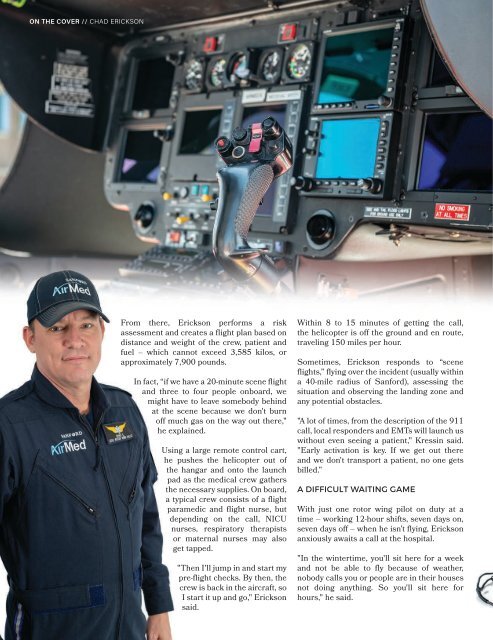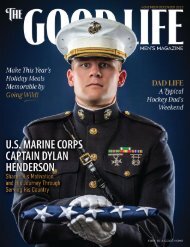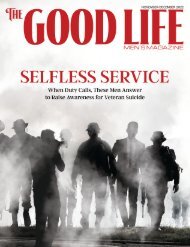The Good Life – July-August 2018
Featuring AirMed Pilot Chad Erickson. Local Hero - Peter Nielsen and K-9 Disco, Mr. Full-Time Dad and more in Fargo Moorhead's only men's magazine.
Featuring AirMed Pilot Chad Erickson. Local Hero - Peter Nielsen and K-9 Disco, Mr. Full-Time Dad and more in Fargo Moorhead's only men's magazine.
You also want an ePaper? Increase the reach of your titles
YUMPU automatically turns print PDFs into web optimized ePapers that Google loves.
ON THE COVER // CHAD ERICKSON<br />
22 / THE GOOD LIFE / urbantoadmedia.com<br />
From there, Erickson performs a risk<br />
assessment and creates a flight plan based on<br />
distance and weight of the crew, patient and<br />
fuel <strong>–</strong> which cannot exceed 3,585 kilos, or<br />
approximately 7,900 pounds.<br />
In fact, “if we have a 20-minute scene flight<br />
and three to four people onboard, we<br />
might have to leave somebody behind<br />
at the scene because we don't burn<br />
off much gas on the way out there,"<br />
he explained.<br />
Using a large remote control cart,<br />
he pushes the helicopter out of<br />
the hangar and onto the launch<br />
pad as the medical crew gathers<br />
the necessary supplies. On board,<br />
a typical crew consists of a flight<br />
paramedic and flight nurse, but<br />
depending on the call, NICU<br />
nurses, respiratory therapists<br />
or maternal nurses may also<br />
get tapped.<br />
"<strong>The</strong>n I'll jump in and start my<br />
pre-flight checks. By then, the<br />
crew is back in the aircraft, so<br />
I start it up and go," Erickson<br />
said.<br />
Within 8 to 15 minutes of getting the call,<br />
the helicopter is off the ground and en route,<br />
traveling 150 miles per hour.<br />
Sometimes, Erickson responds to “scene<br />
flights,” flying over the incident (usually within<br />
a 40-mile radius of Sanford), assessing the<br />
situation and observing the landing zone and<br />
any potential obstacles.<br />
"A lot of times, from the description of the 911<br />
call, local responders and EMTs will launch us<br />
without even seeing a patient," Kressin said.<br />
"Early activation is key. If we get out there<br />
and we don't transport a patient, no one gets<br />
billed.”<br />
A DIFFICULT WAITING GAME<br />
With just one rotor wing pilot on duty at a<br />
time <strong>–</strong> working 12-hour shifts, seven days on,<br />
seven days off <strong>–</strong> when he isn’t flying, Erickson<br />
anxiously awaits a call at the hospital.<br />
"In the wintertime, you'll sit here for a week<br />
and not be able to fly because of weather,<br />
nobody calls you or people are in their houses<br />
not doing anything. So you'll sit here for<br />
hours," he said.


















